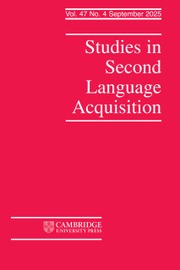Crossref Citations
This article has been cited by the following publications. This list is generated based on data provided by
Crossref.
Barlow, Jessica A.
and
Gierut, Judith A.
1999.
Optimality Theory in Phonological Acquisition.
Journal of Speech, Language, and Hearing Research,
Vol. 42,
Issue. 6,
p.
1482.
Ota, Mitsuhiko
2000.
A review of two books introducing Optimality Theor y.
Second Language Research,
Vol. 16,
Issue. 3,
p.
281.
Hancin-Bhatt, Barbara
2000.
Optimality in second language phonology: codas in Thai ESL.
Second Language Research,
Vol. 16,
Issue. 3,
p.
201.
Alber, Birgit
and
Plag, Ingo
2001.
Epenthesis, deletion and the emergence of the optimal syllable in creole: the case of Sranan.
Lingua,
Vol. 111,
Issue. 11,
p.
811.
Goad, Heather
2002.
Markedness in Right-edge Syllabification: Parallels across Populations.
Canadian Journal of Linguistics/Revue canadienne de linguistique,
Vol. 47,
Issue. 3-4,
p.
151.
Goad, Heather
White, Lydia
and
Steele, Jeffrey
2003.
Missing Inflection in L2 Acquisition: Defective Syntax or LI-Constrained Prosodic Representations?.
Canadian Journal of Linguistics/Revue canadienne de linguistique,
Vol. 48,
Issue. 3-4,
p.
243.
Goad, Heather
and
Rose, Yvan
2003.
Introduction.
Canadian Journal of Linguistics/Revue canadienne de linguistique,
Vol. 48,
Issue. 3-4,
p.
139.
Archibald, John
2003.
Learning to Parse Second Language Consonant Clusters.
Canadian Journal of Linguistics/Revue canadienne de linguistique,
Vol. 48,
Issue. 3-4,
p.
149.
Matthews, John
and
Brown, Cynthia
2004.
When intake exceeds input: Language specific perceptual illusions induced by L1 prosodic constraints.
International Journal of Bilingualism,
Vol. 8,
Issue. 1,
p.
5.
Major, Roy C.
2004.
Gender and stylistic variation in second language phonology.
Language Variation and Change,
Vol. 16,
Issue. 03,
Broselow, Ellen
2004.
Unmarked structures and emergent rankings in second language phonology.
International Journal of Bilingualism,
Vol. 8,
Issue. 1,
p.
51.
Eckman, Fred R.
2004.
FROM PHONEMIC DIFFERENCES TO CONSTRAINT RANKINGS: Research on
Second Language Phonology.
Studies in Second Language Acquisition,
Vol. 26,
Issue. 4,
p.
513.
Yamada, Jun
2004.
An L1-script-transfer-effect fallacy: a rejoinder to Wang et al. (2003).
Cognition,
Vol. 93,
Issue. 2,
p.
127.
Carroll, Susanne E.
2004.
Segmentation: Learning How to ‘Hear Words’ in the L2 Speech Stream.
Transactions of the Philological Society,
Vol. 102,
Issue. 2,
p.
227.
Escudero, Paola
and
Boersma, Paul
2004.
BRIDGING THE GAP BETWEEN L2 SPEECH PERCEPTION RESEARCH AND
PHONOLOGICAL THEORY.
Studies in Second Language Acquisition,
Vol. 26,
Issue. 4,
p.
551.
Trofimovich, Pavel
and
Baker, Wendy
2006.
LEARNING SECOND LANGUAGE SUPRASEGMENTALS: Effect of L2 Experience on Prosody and Fluency Characteristics of L2 Speech.
Studies in Second Language Acquisition,
Vol. 28,
Issue. 01,
Yip, Moira
2006.
The symbiosis between perception and grammar in loanword phonology.
Lingua,
Vol. 116,
Issue. 7,
p.
950.
Davidson, Lisa
2006.
Phonology, phonetics, or frequency: Influences on the production of non-native sequences.
Journal of Phonetics,
Vol. 34,
Issue. 1,
p.
104.
Kerswill, Paul
and
Shockey, Linda
2007.
Phonology in Context.
p.
51.
van Rooy, Bertus
2007.
Consonant Clusters and Resyllabification in Black South African English.
Language Matters,
Vol. 38,
Issue. 1,
p.
26.


